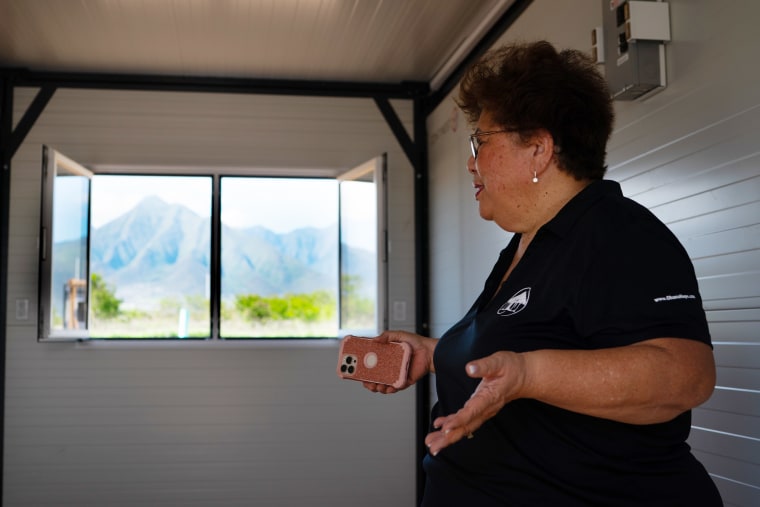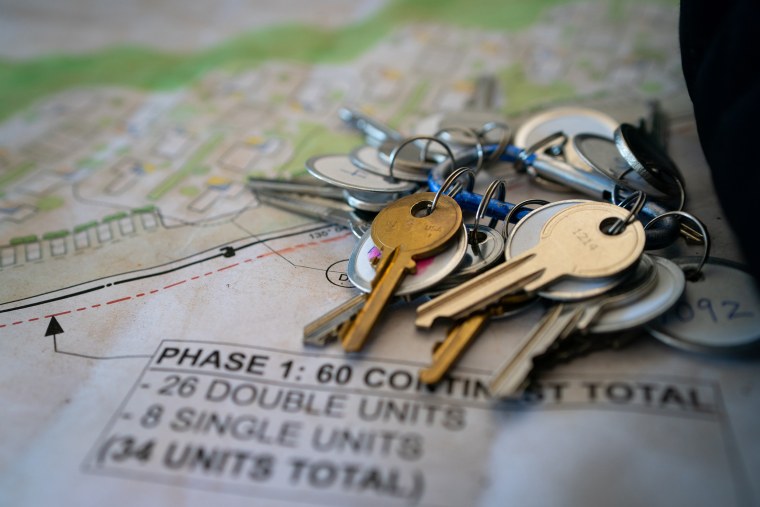LAHAINA, Hawaii – Twelve days after a massive fire ripped through the historic town of Lahaina, killing at least 102 people and destroying nearly 2,200 structures, Maude Cumming rushed to begin construction of housing for survivors.
Through the Family Life Center, his Maui-based nonprofit, Cumming planned to build an 88-unit modular home village.
A year later, only 10 units are occupied, fueling frustration in a community struggling to heal and recover amid ongoing housing insecurity.
“People still aren’t resolved,” Cumming said. “The need is real.”
Designs for the village include 16 pods, each with a private kitchen and bathroom, surrounding a community center with a large porch, or open porch, intended to reflect the traditional Hawaiian way of life. Inside there is a large common kitchen and laundry room.
Financed by $14 million in private donations, the village began to take shape weeks after the fire, but construction soon stalled due to bureaucratic obstacles.
Local building codes required the project to meet commercial standards, and access to a county water line was slowed by preservation efforts, Cumming said.
“Because it was a disaster, we felt it could happen faster than normal,” she said of the permitting process. “We had high hopes.”
Instead, a village that could house more than 300 people has fewer than 30 residents.
One year after the deadliest wildfire in Hawaii’s history, housing insecurity remains one of the biggest obstacles for survivors. ONE recent search of Maui residents by the Hawaii State Rural Health Association found that 59% of people affected by the fire have moved at least three times since last August.
Nearly 1 in 5 respondents said they have moved five or more times.
Cumming said he is aware of families who have moved up to eight times as various housing programs expired or as tensions rise between families or friends offering places to stay.
The instability has rippled through the once-close-knit community, scattering families across Maui and forcing some people to leave the island as rents rise.
Short-term housing has been found for all families who lost their homes, but long-term solutions remain a challenge, largely because rents are so high, according to Gov. Josh Green’s office.

In the days and weeks after the fire, disaster teams sprang into action to help survivors, including temporarily sheltering thousands of people in hotels and later coordinating with local authorities and private organizations to secure temporary housing for 13,000 people. displaced.
“The first year was about survival. The second year is about rebuilding,” Green told NBC News.
Nearly 8,000 people were moved into hotel rooms in the first two weeks after the fire, and 662 survivors were moved into short-term rentals, according to the state Department of Human Services.
Since then, displaced families have received help through a combination of rental assistance programs, transitional housing, and disaster management.
The first 10 families will soon move into a temporary housing complex designed to house 1,200 people for up to five years. And 3,000 people found accommodations through a partnership with Airbnb, the Department of Human Services said.

As for Cumming’s project, she plans to finish it in the next few months after the Family Life Center receives delivery of a water pipe that will allow the modular home village to connect to a county water line, she said.
“I would like this to be a model for disaster response,” she said. “That’s what’s safe. This is what can be vomited in a short space of time. If we can achieve that, I’d say it was worth it.”
The project remains empty as people continue to wait for housing, Green said, but “there are tradeoffs when you have a crisis like this.”
“In general, you want to do bigger, more permanent projects,” he said.
But Cumming said he can hear concern in the voices of people who don’t know what will happen in the next two or three months.
“It’s this uncertainty that leaves people still on alert,” she said.
This story originally appeared on NBCNews.com read the full story
















/cdn.vox-cdn.com/uploads/chorus_asset/file/25555597/DSCF7455.jpg?w=300&resize=300,300&ssl=1)





/cdn.vox-cdn.com/uploads/chorus_asset/file/22045883/cwelch_201114_4292_0005.0.jpg?w=300&resize=300,300&ssl=1)














